Articles
- Page Path
- HOME > J Korean Powder Metall Inst > Volume 23(3); 2016 > Article
-
ARTICLE
- Spark Plasma Sintering of Fe-Ni-Cu-Mo-C Low Alloy Steel Powder
- Hong-Hai Nguyen, Minh-Thuyet Nguyen, Won Joo Kim, Ho Yoon Kim, Sung Gye Parka, Jin-Chun Kim*
-
Journal of Korean Powder Metallurgy Institute 2016;23(3):207-212.
DOI: https://doi.org/10.4150/KPMI.2016.23.3.207
Published online: May 31, 2016
School of Materials Science and Engineering, University of Ulsan, 93 Daehak-ro, Nam-gu, Ulsan 44610, Korea
a Research Laboratory, Metal Tech Co., Ltd., 21 Maegoksaneop-ro, Buk-gu, Ulsan 44222, Korea
- *Corresponding Author: Jin-Chun Kim, +82-52-259-2231, +82-52-259-1688, jckimpml@ulsan.ac.kr
• Received: May 12, 2016 • Revised: June 14, 2016 • Accepted: June 16, 2016
© The Korean Powder Metallurgy Institute. All rights reserved
- 967 Views
- 6 Download
- 4 Crossref
Abstract
- In this study, Fe-Cu-Ni-Mo-C low alloy steel powder is consolidated by spark plasma sintering (SPS) process. The internal structure and the surface fracture behavior are studied using field-emission scanning electron microscopy and optical microscopy techniques. The bulk samples are polished and etched in order to observe the internal structure. The sample sintered at 900°C with holding time of 10 minutes achieves nearly full density of 98.9% while the density of the as-received conventionally sintered product is 90.3%. The fracture microstructures indicate that the sample prepared at 900°C by the SPS process is hard to break out because of the presence of both grain boundaries and internal particle fractures. Moreover, the lamellar pearlite structure is also observed in this sample. The samples sintered at 1000 and 1100°C exhibit a large number of tiny particles and pores due to the melting of Cu and aggregation of the alloy elements during the SPS process. The highest hardness value of 296.52 HV is observed for the sample sintered at 900°C with holding time of 10 minutes.
- Fe-Cu-Ni-Mo-C based materials are used for structural applications such as camshaft and crankshaft sprockets, connecting rods, bearing caps, oil pump gears and so on [1, 2]. Fe-Ni-Cu-Mo-C sintered low alloy steel has received great attendance by several researchers [3, 4]. The addition of alloy elements leads to enhance fracture toughness, microhardness and strength. It has both high compaction and excellent mechanical properties. When low alloy steel products are applied in high mechanical friction and vibration, and elevated pressure environment, They must have suitable mechanical properties, low porosity and good densification to avoid defects that are the one of the most serious causes leading to destruction. Many previous researches had tried to fabricate low alloy steel powders by using various sintering methods with the relative density under 93% such as pressureless, hot-pressed and hot isostatic pressing sintering [5-8]. Therefore, to achieve a near theoretical density with lower sintering temperature compared to above methods, a novel sintering process named spark plasma sintering was used to consolidate low alloy steel powder in this study.
- A consolidation technique known as spark plasma sintering (SPS) has become widespread in us and attracted considerable attention. This process involves simultaneous action of pressure, temperature and pulse electric current. It makes possible the synthesis of materials and components from metals, ceramics, polymers and composites to highly advanced functionally graded materials, and thermoelectric semiconductors [9-12]. With such features SPS system possesses a lot of advantages such as rapid sintering, less sintering additives, uniform sintering, low cost, easy experimental procedure compared to conventional sintering processes [13-15].
- This work focused on manufacturing low alloy steel bulk sample using SPS process and investigating some characteristics such as etched microstructure, relative density, hardness and fractured surface evolution during sintering.
Introduction
- Low alloy steel powder was synthesized by using atomization method and used as a starting powder in the present study. The chemical composition of the starting material was analyzed as 0.5~0.8% C, 1~2% Cu, 3~5% Ni, 0.2~0.8% Mo in weight fraction. Low alloy steel powder was placed in a high density graphite die of internal diameter 10 mm. In order to avoid the interaction of powder with graphite die and punches, a piece of grafoil sheet was lined between them. The powder was filled in the die and then placed inside the chamber of SPS system named SPS-515S model (Sumitomo Coal Mining Company Ltd.). A pressure of 50 MPa was applied during sintering processing. The densification was performed in vacuum chamber between 800°C and 1100°C with a heating rate of 50°C/min. When the temperature reached the setting point, holding time was continued for 10 min at that temperature. After completing process, SPS chamber was cooled down to room temperature by using water system inside SPS machine and the pellets were ejected from the die. The ejected pellets were cleaned to remove the grafoil sheets. Samples were grinded using a series of grit silicon carbide papers ranging from P-800 to P-2400 and polished using Allied alumina powder (0.05 μm). The samples were etched by using the solution of 90% Ethanol (96%) and 10% Nitric Acid (1.40) in volume fraction for 60 seconds. The fractured and etched surfaces were observed by using field emission scanning electron microscopy (FESEM – JEOL JSM-6500F) and optical microscopy (OM – Olympus PMG3). The density of sintered compacts was measured by Archimedes principle based on water displacement technique. Mechanical property of the bulk samples was measured by mirco-Vickers hardness (Mitutoyo MVKH1) with the load of 500 g.
Experimental Procedure
- Fig. 1 shows the morphology of the powder and the fractured surfaces of different sintering operations. Before sintering, the atomized powder was examined by using FE-SEM to know the shape and particle size (Fig. 1(a)). Generally, the powder has a complex shape with the particle size under 100 μm. Fig. 1(b) presents the fractured surface of received product. The density of the received conventionally sintered product is only 90.3%. So, the fracture surface has many pores as a result of conventional sintering process. The fracture was mainly at grain boundaries that shows the weaker mechanical properties. The inset indicates the deformation before demolition with the two smooth sides (pores). Fig. 1(c) and (d) are the fractured surfaces of SPSed bulk samples sintered at 800°C and 900°C. At 800°C, the consolidation was caused by the effect of pressure. However, at 900°C, the fractured surface was different compared to that at 800°C. Specifically, the surface has high close-packed and the sample was hard to break out. Moreover, there are both grain boundaries and internal particle fractures. The demolition at grain boundaries shows a strong deformation before breaking out with high strain compared to the surface of received product.
- Fig. 2 shows the fractured surface of the bulk samples sintered at 1000°C and 1100°C. Both samples have mainly internal particle demolition. There are a lot of sub-micro particle with the size under 1 μm (insets). By using EDS, these particle’s composition was examined. Due to having low melting temperature, Cu tends to aggregate and form the solid solution in ferrite [16]. The high temperature of plasma spark generated in the gap between neighboring powder particles partly melt Cu at the affected areas making a lot of tiny particles and pores by the change of volume fraction [10, 17]. Specially, at 1100°C (Fig 2(b)), the development of the Cu content in ferrite led these particles to become bigger as a result of the occurrence of defects. So at 900°C sintering, the sample got the best fractured surface characteristic.
- To know about microstructure of SPSed samples, the etching process was taken place and then using OM to know internal structure (Fig. 3). The received sample indicates a big particle with clear boundary. However, the 800°C SPSed sample shows many particles with different structure directions (Fig. 3(b) and (c)). High pressure and plasma flow during sintering led the surface smoother compared to the received sample. The internal structure looks like lamellar pearlite. At 900°C, the pearlite microstructure was not changed and interspersed with white hypoeutectoid cementite (Fig 3(d)). However, at 1000°C, the grain boundaries can see clearly due to the aggregation of alloy elements (Fig. 3(e)). Increasing temperature to 1100°C, the grains become bigger with thicker alloy layer (Fig. 3(f)).
- Fig. 4 shows the FE-SEM images of etched received and sintered samples at different temperature. By using conventional thermal sintering method, the received sample has tree branch structure (Fig. 4(a)) with high carbon weight fraction (EDS inset below). In other hand, the lamellar pearlite structure is easy to indicate in Fig. 4(b) and (c), which confirms the hypothesis that has been presented in OM etched analysis. The aggregation of alloy element also was examined with high concentration of Ni. This phenomenon is due to the existence of Ni and Cu elements in this alloy steel leading to the formation of solid solutions in ferrite [16]. When the temperature increases, the aggregation occurs faster due to mass transportation from pearlite to ferrite. In EDS analysis, the content of alloy elements reduces in pearlite (selected area 1) and enhances in ferrite (selected area 2) following the increasing of temperature.
- Fig. 5 shows the density and hardness of the received and SPSed samples. At 800°C, the sample was only packed by the influence of densification such as the shrinkage of pores, repackage of particles, therefore, the density is low. However, increasing temperature to 900°C, the density increases quickly and gets 98.9% of the theoretical one and is higher than the conventional sintering product which has only 7.064 g/cm3 in density (relative density; 90.3%). At 1000°C and 1100°C, due to the aggregation and mass transportation of alloy elements to particle boundaries, followed by the dissolution of them in ferrite, the samples appeared a lot of tiny pores and high alloy concentrated particles leading to the decrease of density compared to 900°C SPSed sample. The hardness of SPSed samples is higher than the received one, which shows the efficiency of SPS process. The target sintered condition at 900°C reaches 296.5 HV in hardness and is 40 HV higher than conventional sintering method. During the sintering process, there is no new phase formation or transformation with a small scale of Cu and Ni dissolution in ferrite. In addition, pearlite theoretically has higher hardness compared to ferrite [18], however, the ferrite solution consisting of high Cu and Ni elements was uniformly distributed around pearlites with thin thickness. Therefore, the hardness value of 1000°C and 1100°C sintered samples generally are nearly equal compared to the 900°C one.
- The existence of tiny pores and high alloy concentrated particles in the samples sintered at 1000°C and 1100°C are predicted to cause defects when applying in actual use. To avoid this problem, the sintering process for this powder was suggested to be carried out at 900°C.
Results and Discussion
Fig. 1
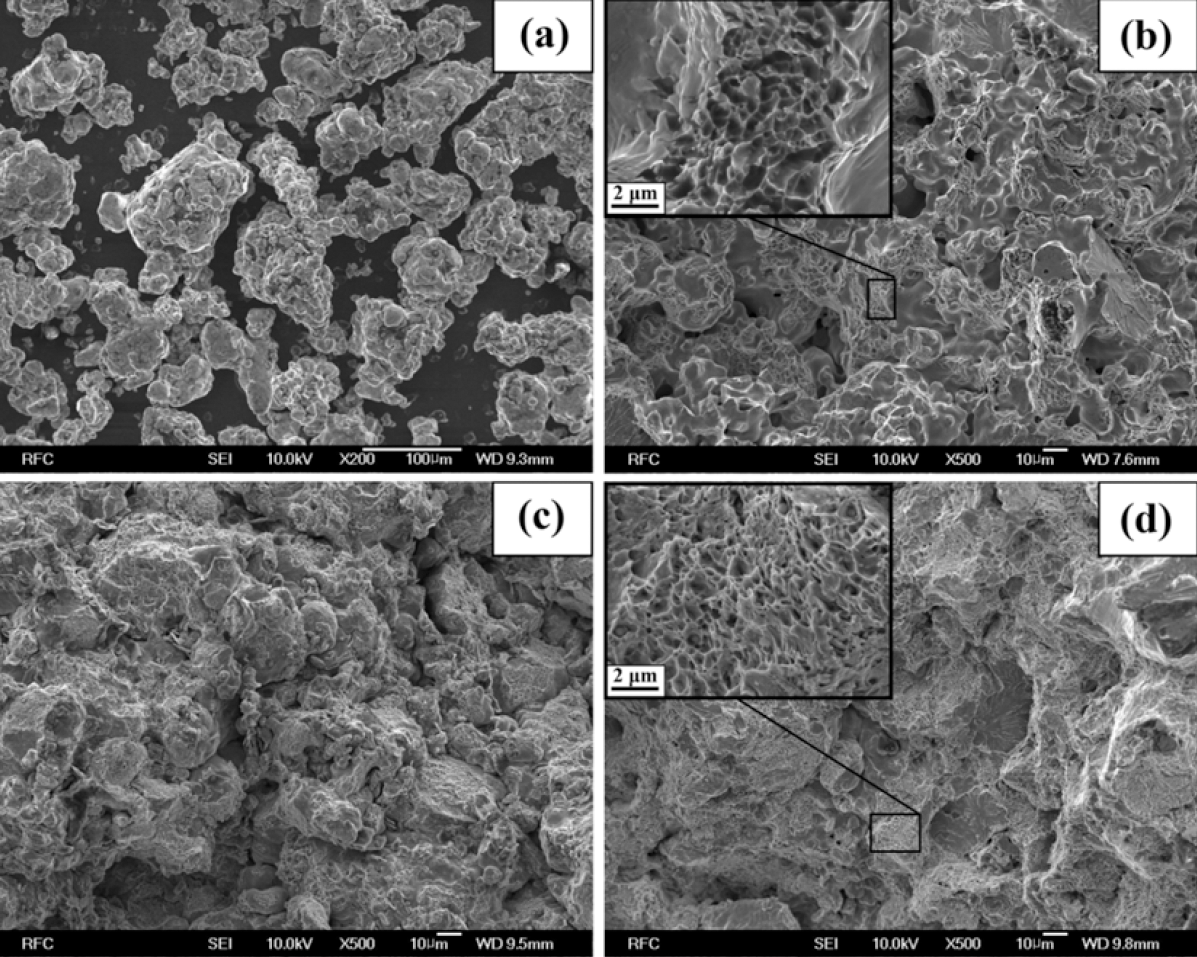
The FE-SEM images of (a) the received powder, (b) the received product, and the bulk samples spark plasma sintered at (c) 800°C and (d) 900°C.

Fig. 2
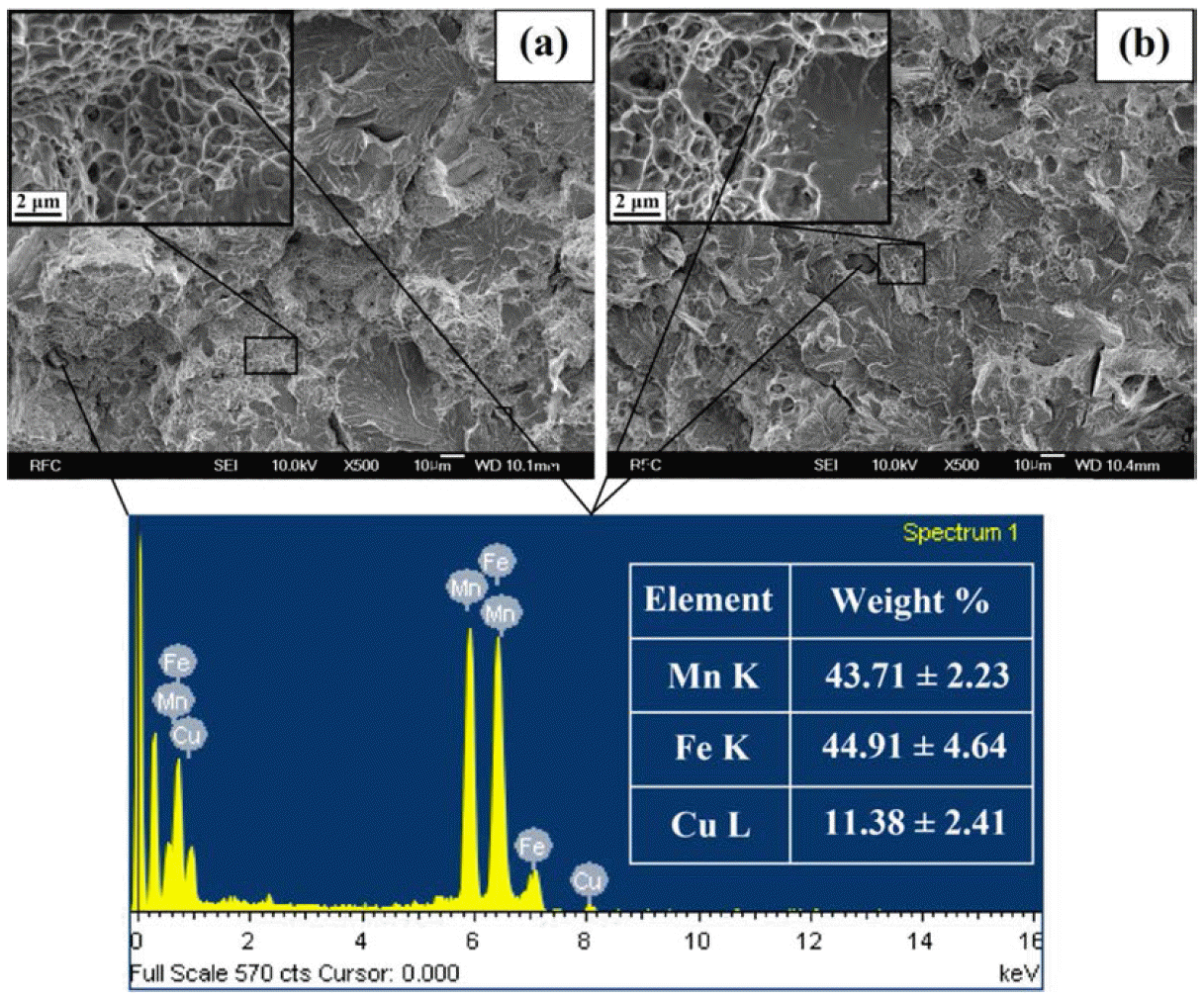
The FE-SEM images of the samples SPSed at (a) 1000°C and (b) 1100°C, and EDS of selected particles below.

Fig. 3
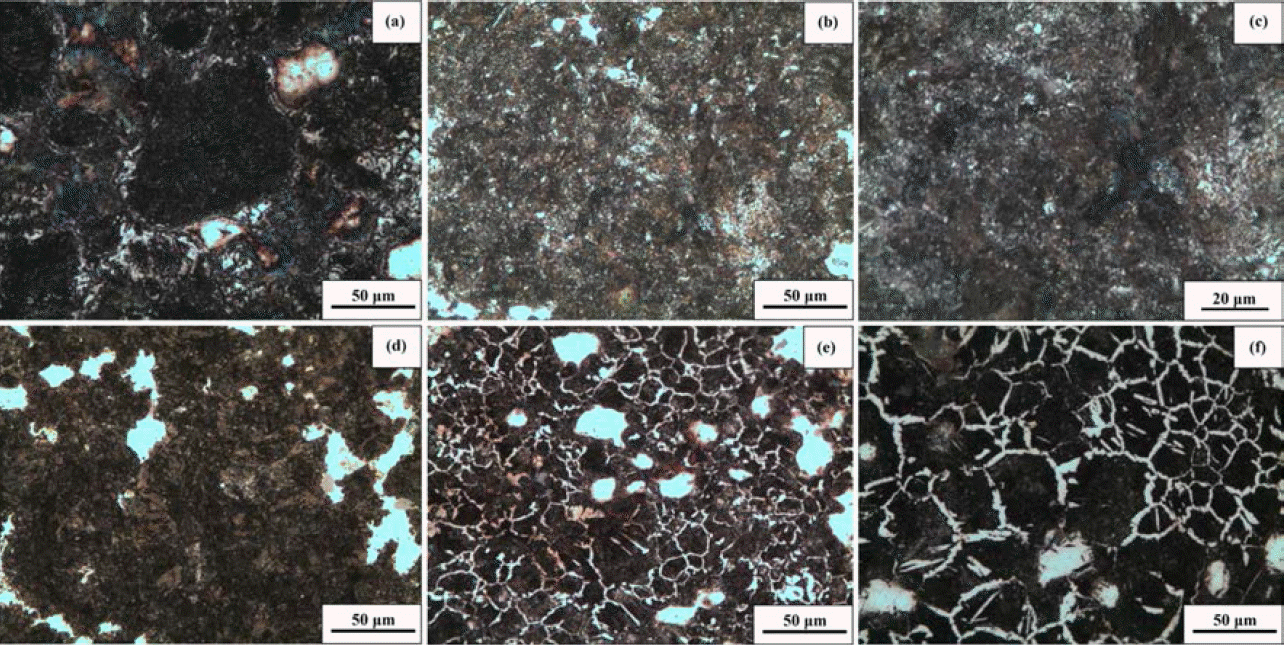
the OM images of the etched samples for (a) received product, SPSed at (b) and (c) 800°C with different magnifications, (d) 900°C, (e) 1000°C, and (f) 1100°C.

Fig. 4
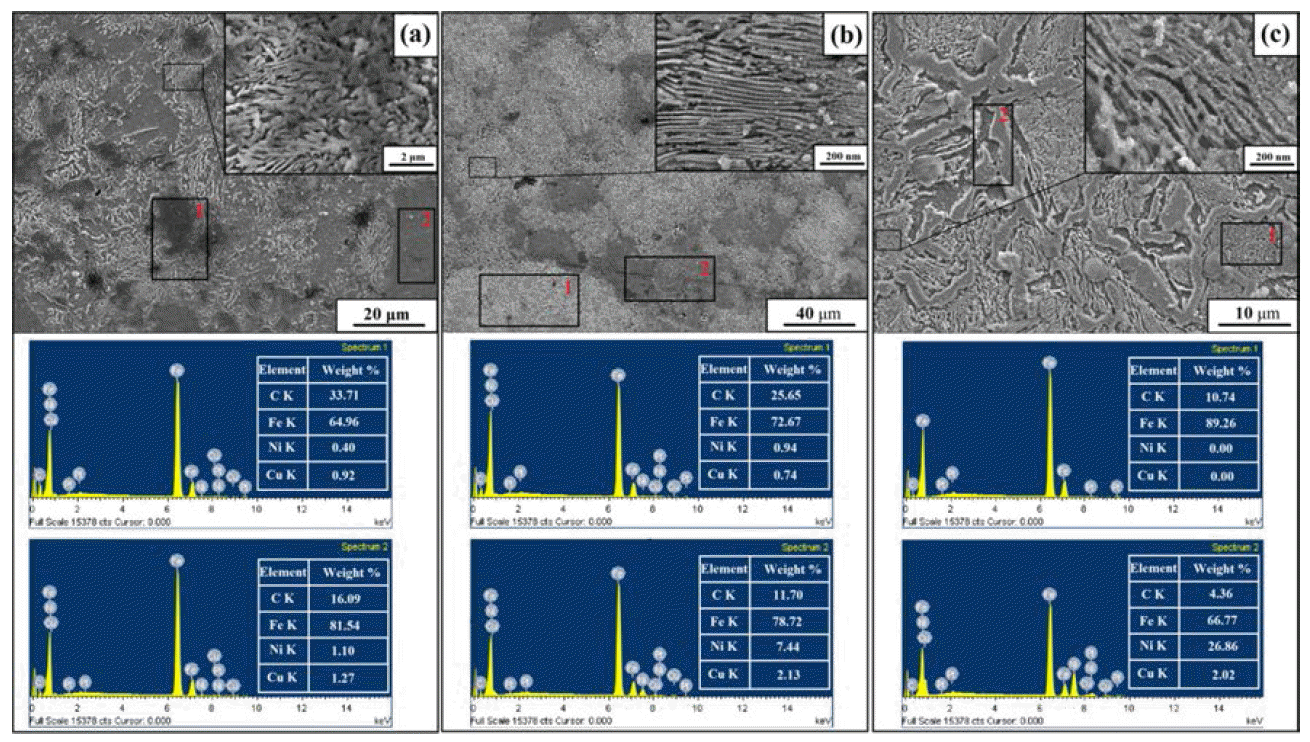
FE-SEM images of the etched samples for (a) received product and SPSed at (b) 900°C and (c) 1100°C, and their below EDS analysis, respectively.

Fig. 5
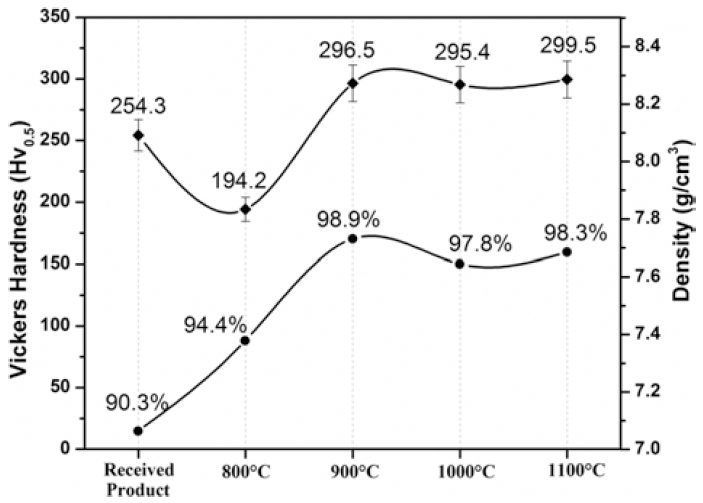
Density and Vicker hardness of received product and SPSed samples at different sintering temperatures.

- Near theoretical dense low alloy steel compacts were obtained by spark plasma sintering at comparatively lower temperature and holding time than conventional sintering technique. The sample sintered at higher than 800°C has same microstructure (lamellar pearlites interspersed with white cementite). At 900°C sintering, the sample reached 98.9% of theoretical density and 296.5 HV of hardness. The aggregation and dissolution of alloy elements in ferrite occurred both the internal and boundary of particles leading to the appearance of small particle and tiny pores, and the high concentrated alloy layer network surrounding the particle colonies. Both density and hardness of SPSed sample are higher than conventional product.
Conclusions
-
Acknowledgements
- This work was financially supported by the 2016 Research Fund of the University of Ulsan.
Acknowledgements
- 1. I Chang and Y Zhao, Advances in Powder Metallurgy: Properties, Processing and Applications, (2013) Woodhead Publishing, UK.
- 2. R Yilmaz and M R Ekici: Journal of Achievements in Materials and Manufacturing Engineering., (2008) 31 23.
- 3. H Khorsand, S M Habibi, H Yoozbashizadea, K Janghorban, S M S Reihani, H Rahmani Seraji and M Ashtari: Mater. Des., (2002) 23 667.Article
- 4. Y H Lu, Z Y Xiao, L Hu, F Luo, Y B Wu and D H Ni: Mater. Des., (2004) 55 758.Article
- 5. B López, I Gutiérrez and J J Urcola: Mater. Charact., (1992) 28 49.
- 6. G Navarro, M A Jabbari Taleghani and J M Torralba: Powder Metall., (2013) 56 11.Article
- 7. R J Causton and J J Fulmer: Adv. Powder. Metall. Part. Mater., (1992) 5 17.
- 8. M D Charre, Microstructure of Steels and Cast Irons, (2003) Springer, 284.
- 9. M Tokita: Materials Science Forum., (1999) 308 83.
- 10. R Chaim: Mater. Sci. Eng. A., (2007) 443 25.Article
- 11. N Saheb, Z Iqbal, A Khalil, A S Hakeem, N A Aqeeli, T Laoui, A A Quitub and R Kirchner: J. Nanomater., (2012) 2012 1.ArticlePDF
- 12. M Schwertz, S Lemonnier, E Barraud, A Carrado, M F Vallat and M Nardin: Powder Metall., (2015) 58 87.Article
- 13. B Ertug, M Suaìrez, A Fernández, J L Meneìndez, R Torrecillas, H U Kessel, J Hennicke, R Kirchner and T Kessel: Sintering Applications., (2013) InTech, 319.
- 14. Z A Munir, U Anselmi-Tamburini and M Ohyanagi: J. Mater. Sci., (2006) 41 763.ArticlePDF
- 15. F Zhang, M Reich, O Kessler and E Burkel: Mater. Today., (2013) 16 192.Article
- 16. S N Bagchi and K Prakash, Industrial Steel Reference Book, (1986) New Age International, New Delhi.
- 17. M Tokia: J. Soc. Powder Technol. Japan., (1993) 30 790.
- 18. C J Mccauley, E Oberg, F D Jones, H L Horton and H H Ryffel, Machinery's Handbook, (2012) Industrial Press, New York.
References
Figure & Data
References
Citations
Citations to this article as recorded by 

- Fabrication of Fe-Si-B Based Amorphous Powder Cores by Spark Plasma Sintered and Their Magnetic Properties
Liang Yan, Biao Yan, Yin Jian
Materials.2022; 15(4): 1603. CrossRef - Effect of Milling Time and Addition of PCA on Austenite Stability of Fe-7%Mn Alloy
Seung-Jin Oh, In-Jin Shon, Seok-Jae Lee
Journal of Korean Powder Metallurgy Institute.2018; 25(2): 126. CrossRef - Sintering and Microstructures of SUS 316L Powder Produced by 3D Printing Process
W.J. Kim, H.-H. Nguyen, H.Y. Kim, M.-T. Nguyen, H.S. Park, J.-C. Kim
Archives of Metallurgy and Materials.2017; 62(2): 1215. CrossRef - Fabrication and Mechanical Property of Fe-20Cu-1C Compacts by SPS process with Different Heating Rate
Jung-Han Ryu, Soo-Sik Shin, Byung-Rok Ryu, Kyung-Sik Kim, Jun-Ho Jang, Ik-Hyun Oh, Kap-Tae Kim, Hyun-Kuk Park
Journal of Korean Powder Metallurgy Institute.2017; 24(4): 302. CrossRef
-
 Cite this Article
Cite this Article
- Cite this Article
-
- Close
- Download Citation
- Close
- Figure
- Related articles
Spark Plasma Sintering of Fe-Ni-Cu-Mo-C Low Alloy Steel Powder





Fig. 1
The FE-SEM images of (a) the received powder, (b) the received product, and the bulk samples spark plasma sintered at (c) 800°C and (d) 900°C.
Fig. 2
The FE-SEM images of the samples SPSed at (a) 1000°C and (b) 1100°C, and EDS of selected particles below.
Fig. 3
the OM images of the etched samples for (a) received product, SPSed at (b) and (c) 800°C with different magnifications, (d) 900°C, (e) 1000°C, and (f) 1100°C.
Fig. 4
FE-SEM images of the etched samples for (a) received product and SPSed at (b) 900°C and (c) 1100°C, and their below EDS analysis, respectively.
Fig. 5
Density and Vicker hardness of received product and SPSed samples at different sintering temperatures.
Fig. 1
Fig. 2
Fig. 3
Fig. 4
Fig. 5
Spark Plasma Sintering of Fe-Ni-Cu-Mo-C Low Alloy Steel Powder
TOP
 KPMI
KPMI







